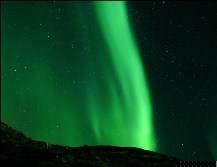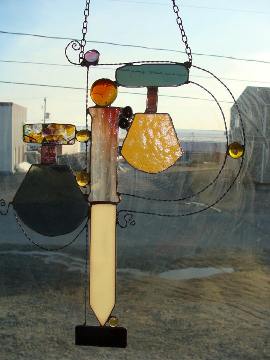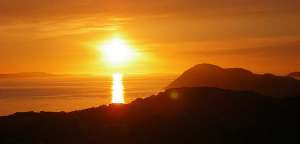
Where is North?
It’s a matter of direction and degree. The north pole at 90⁰N (north latitude) is as far north as it gets on earth. The treeline, beyond which trees don’t grow because of ice, snow and cold, is at 50⁰N in some places. Above 60⁰ the land is pretty well all frozen all winter long.
To Americans, Canada is a northern country because it runs north of the United States. The U.S.-Canada border dipsy-doodles around 49⁰N and below (Toronto is at 43⁰N, Montreal and Ottawa at 45⁰N). Most Canadians by far — more than nine out of ten — live within 100 miles or about 1.5⁰ of this border. We hug our big neighbour very tightly.
Canadians are a northern people we say, guardians of the True North our anthem sings. We’re proud that the tiny hamlet of Alert at 82⁰N is the place furthest north on the planet that is continuously occupied. Alert’s motto, Inuit Nunangata, means beyond the land of the Inuit. The permanent population of Alert is zero but there are always a few dozen people there on a rotating basis because it’s a weather and military signals monitoring station and a short-term destination for northern researchers. Umiujaq, where Pammy’s great4granddaughter Kerrin and her Inuk foster daughter live, is just above 56⁰N.
But the real truth is we’re a northern people in name only.
 Our North measures 4,650,000 square kilometers (46% of Canada) and has a total population of 110,000, more than half aboriginal (about 50,000 Inuit and 15,000 other indigenous peoples, including Dene, Metis and Cree.)
Our North measures 4,650,000 square kilometers (46% of Canada) and has a total population of 110,000, more than half aboriginal (about 50,000 Inuit and 15,000 other indigenous peoples, including Dene, Metis and Cree.)
The North for the United States, Alaska, is the largest state in the union by area, with a population of about 750,000, just 15% aboriginal, largely employed in gas, oil and government, including the U.S. military. Disconnected from the lower 48, Alaska lies mainly between 60⁰N and 70⁰N.
I won’t belabour Helsinki, 1.5 million people at 60⁰N (all of Finland’s 5.5 million people live between 60⁰N and 70⁰N), Stockholm with 1.3 million and Oslo with 1.4 million at 59⁰N, Narvik, Norway with 19,000 people just above 68⁰N.
But the real rival claimant to northern pre-eminence is Siberia. At just over 13 million km2, approximately 10% of earth’s total land area, Siberia is 77% of Russia, with a population of 40 million. Very few (~6%) are indigenous, although some Mongols and Tatars were Siberian before the onslaught of Russia started in the 16th century. There are big cities in Siberia. The regional admin centre Novosibirsk is at 55⁰N with more than 1.5 million inhabitants.The longest railway in the world is the Trans-Siberian.
 Canada has no cities of any size above 55⁰N. Edmonton, with a population of 800,000, is at 53⁰N. North of Edmonton, stretching east and west from the Pacific to Hudson Bay, you’d have to look hard to find a total of 250,000 people, whites and Inuit together. About a quarter of these are at Fort McMurray (56⁰N) stripping the Alberta tar sands. Another 60,000 are pushing paper and serving drinks to tourists in the territorial capitals of Yellowknife in the Northwest Territories (60⁰N), Whitehorse in the Yukon (60⁰N) and Iqaluit in Nunavut (63⁰N). The rest are dispersed through dozens of settlements and traditional villages, most with fewer than a thousand inhabitants. Nunavut, carved from the Northwest Territories in 1999, has the most land and the least people of all 13 provinces and territories. In an area larger than all but the biggest dozen of the 249 countries in the world, including Canada itself, there are just 32,000 people, more than four out of five of them Inuit. There were 445 people in Umiujaq when Kerrin arrived in 2011. Umiujaq is one of 14 villages in Quebec’s northern territory of Nunavik, with a total population of just over 12,000 of whom 90% are Inuit. Nunavik is tiny beside Nunavut but larger than California.
Canada has no cities of any size above 55⁰N. Edmonton, with a population of 800,000, is at 53⁰N. North of Edmonton, stretching east and west from the Pacific to Hudson Bay, you’d have to look hard to find a total of 250,000 people, whites and Inuit together. About a quarter of these are at Fort McMurray (56⁰N) stripping the Alberta tar sands. Another 60,000 are pushing paper and serving drinks to tourists in the territorial capitals of Yellowknife in the Northwest Territories (60⁰N), Whitehorse in the Yukon (60⁰N) and Iqaluit in Nunavut (63⁰N). The rest are dispersed through dozens of settlements and traditional villages, most with fewer than a thousand inhabitants. Nunavut, carved from the Northwest Territories in 1999, has the most land and the least people of all 13 provinces and territories. In an area larger than all but the biggest dozen of the 249 countries in the world, including Canada itself, there are just 32,000 people, more than four out of five of them Inuit. There were 445 people in Umiujaq when Kerrin arrived in 2011. Umiujaq is one of 14 villages in Quebec’s northern territory of Nunavik, with a total population of just over 12,000 of whom 90% are Inuit. Nunavik is tiny beside Nunavut but larger than California.
 On the other side of the pole a different North is found. Moscow, the capital of all the Russians, sits at 55⁰N latitude, with a population around 11.5 million. St. Petersburg, with five million people, is at 60⁰N. More than half the area of Russia is still further North, with cities such as Archangel, with 350,000 people at 64⁰N, Murmansk, with a population of 319,000 at 68⁰N, Vorcuta, with 75,000 Vorcutans at 67⁰N and Norilsk, 165,000 at 69⁰N. Canada has only three hamlets at this latitude, with a total of 1,182 mainly Inuit residents.
On the other side of the pole a different North is found. Moscow, the capital of all the Russians, sits at 55⁰N latitude, with a population around 11.5 million. St. Petersburg, with five million people, is at 60⁰N. More than half the area of Russia is still further North, with cities such as Archangel, with 350,000 people at 64⁰N, Murmansk, with a population of 319,000 at 68⁰N, Vorcuta, with 75,000 Vorcutans at 67⁰N and Norilsk, 165,000 at 69⁰N. Canada has only three hamlets at this latitude, with a total of 1,182 mainly Inuit residents.
There’s a lot more experience of the North around the world than Canada is any part of. Canada’s North is lightly occupied, scarcely developed and virtually unknown to Canadians themselves, Inuit excepted. We just have lucked into a huge slice of the planet that the rest of the world hasn’t had any use for until now.
And there’s the rub. Now the North is coming into its own. Now it is the focal point and early warning beacon for global climate change. Now international capital and technology are mobilizing to extract its almost limitless resources. Now shippers see an ice free passage open longer each year in the northwest, with its promise of faster times and lower costs to move commodities between Asia and Europe. The benign neglect that has kept the pride of Canada a private preserve won’t do for tomorrow. It is time to re-assess our interests in the North and the rights of its original people, the Inuit.
The Throne Speech of October 2013 boasted that, “Canada’s greatest dreams are to be found in our highest latitudes. They are the dreams of a North confident and prosperous.”
Do we really have any right to such a claim? Not judged by our accomplishments. A current prime example is the final extension of the Dempster Highway, which starts near Dawson in the Yukon and runs 736 km across the Arctic Circle to Inuvik in the Northwest Territories. This was part of Prime Minister Diefenbaker’s northern vision. He got the all-season road underway in 1958 when he was in office but high cost and disputes between Ottawa and the Yukon made it very much a start-and-stop project that took 21 years to get to Inuvik. The vision dimmed as Dief did. It wasn’t until 2013 that construction started on the 140 km link from Inuvik to Tuktoyaktuk, a project half a century in the talking stage.
That’s the big one. But “building the Canadian North is an essential part of building our nation” are the first words of Canada’s northern strategy, introduced by the present government of Canada in 2007, so of course there are some other initiatives.
Rangers are a particular pride of the Inuit community. Some of the strongest young leaders become Rangers. There are 5,000 Rangers. Note the number. It’s about 10% of the Inuit population. Not entirely a coincidence. Rangers are important to the Inuit and the hundreds of communities through the North where they live. They are role models and their patrols through remote communities and areas serve a number of ends. Sovereignty is among them, but search and rescue or emergency assistance are more practical and better appreciated. They have no real military role. Ten days of orientation is all that’s required to train new Rangers. They are each employed a few weeks each year. Their 60-year old Lee Enfield rifles were supposed to be replaced last fall (2013), but that upgrade has been postponed by at least three years.
Search as hard as you can, you won’t find as much as $250 million spread over four or five years as evidence of this “building our nation”, money to be spent on everything from housing to adult education to species protection and harbour and hydro developments. To put that amount in context, it’s what was spent recently to renovate the Canadian Museum of Nature on the street where I live in Ottawa.
 We have talking the talk down perfectly, despite the woeful record. “The Government of Canada has made the North one of its top priorities. Through our northern strategy, we are working to ensure Canada’s North achieves its full potential as a healthy, prosperous region within a strong and sovereign Canada.”
We have talking the talk down perfectly, despite the woeful record. “The Government of Canada has made the North one of its top priorities. Through our northern strategy, we are working to ensure Canada’s North achieves its full potential as a healthy, prosperous region within a strong and sovereign Canada.”
In response to this persiflage, Yevgeny Lukyanov, the deputy secretary of the Security Council of the Russian Federation, explains what’s meant by walking the walk. “For the Russian economy, there are no alternatives for the majority of resources extracted in the North,” he says. “These resources provide Russia’s strategic security and will be a determining factor in lifting and modernizing its economy.” The Russian Arctic produces 11% of the country’s GNP, 93% of its natural gas and 75% of its oil. A good deal of the infrastructure required to further exploit Russia’s Arctic is already in place. Russia is actively promoting its northern sea route as an alternative to the fabled but elusive Northwest Passage.
“For the majority of Russians, the Arctic and everything connected to it is not an abstract concept or romantic exotica, but a practical and vitally important reality,” says Lukyanov. For most Canadians it is precisely the reverse, a romantic vision, a place dreamed of but difficult to get to. Most but not all. For the Canadian Inuit the North indeed is vitally important. This is their home as it has been through millennia. These magnificent people alone have the skill of survival at the frozen edge of existence. On their strength Canada must rely through the difficult northern century ahead.
But let’s be serious. There are 50,000 Inuit in a land bigger than India, which has 1.2 billion people. Canada’s North doesn’t come near India. But it touches two of the world’s most aggressive superpowers, both with northern investments that far outstrip Canada’s and populations above 60⁰N trained in the industrial economy that outnumber our Inuit vanguard by roughly 700 to 1.
Got to find a way to better these odds for Kerrin’s Inuk foster daughter. And soon.
The following links will bring you to Part 1 of this series, Yellowknife, Part 2, Kangiqsualujjuaq, and Part 3, Umiujaq
Rideau Canal And All That
How Canada Came To Be Best

Fascinating information. What to do . . .what to do ???